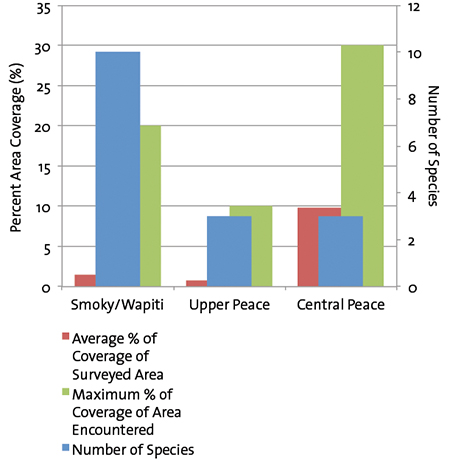InvasivesInvasives, also often called exotic species, are plants and animals that evolved elsewhere but thrive in their new environment. They can feed on native species, or take over their habitat and cause local extirpations. Not only do invasives affect native flora and fauna, but they can have economic costs. For example, crops may require expensive applications of herbicides to kill invasive weeds. Herbicide use also increases the risk of contaminated waterways. Governments and stewardship organizations monitor and control invasives, but it is a challenging task, and data are sparse. This section addresses only invasive species in waterways, wetlands and riparian areas. Findings from stewardship groups and government monitoring agencies are included. However, given the size of the watershed and the lack of coordination among monitoring programs, these findings are not comprehensive. Invasive plants are introduced by vegetative means, seeds and spores which may be transported by birds, animals, wind, water and human activities including agriculture, forestry, and recreation to name a few. Aquatic species are often introduced through the release of exotic baitfish and worms, and non-inspected boat transfer. Aquatic Invasive Species
|
Invasive Plant Species in Riparian Areas Source: CPP Environmental, Hutchinson Env. Sci. Ltd. (2014) TO PARTICIPATE IN REPORTING AND CONTROLLING INVASIVES, SEE:
• http://www.anpc.ab.ca/wiki/index.php?title=Main_Page• esrd.alberta.ca/recreation-public-use/invasive-species • www.ec.gc.ca/eee-ias • www.abinvasives.ca • mywildalberta.com • www.cowsandfish.org FOR MORE ON INVASIVE SPECIES IN THE MIGHTY PEACE
State of the Watershed Aquatic Ecosystems. February 2014, available on the Alliance website
here. |
| © 2015 Mighty Peace Watershed Alliance | CONTACT THE ALLIANCE |
NEXT PAGE: Surface Water Quantity |